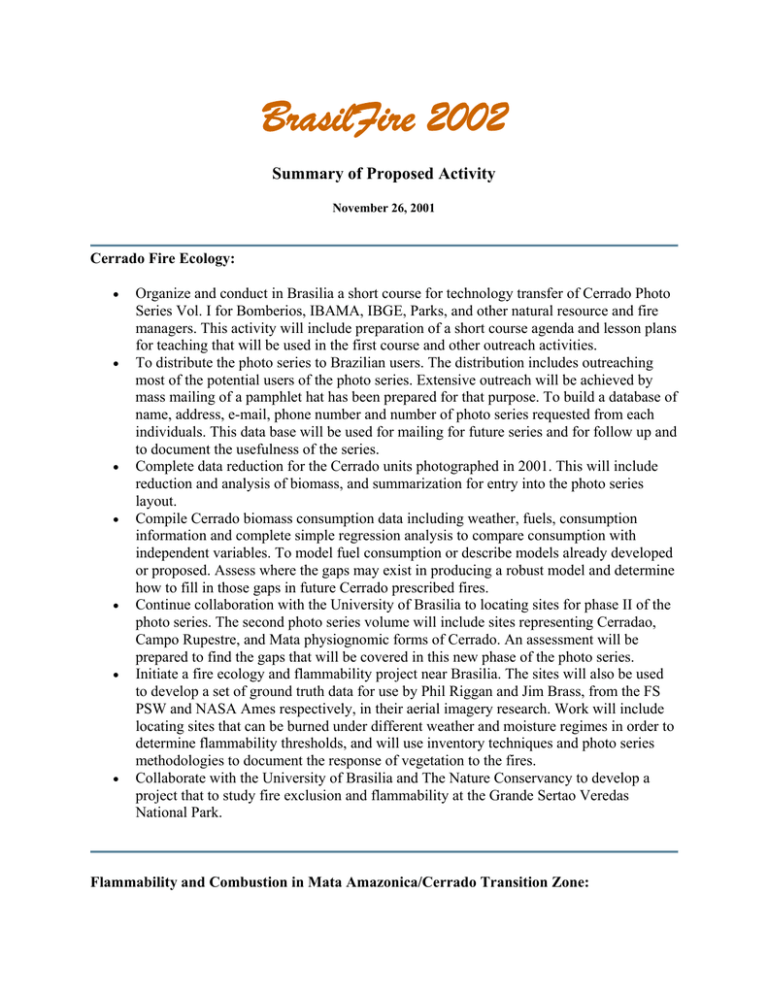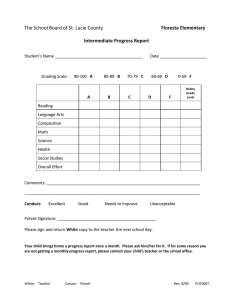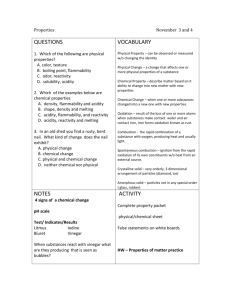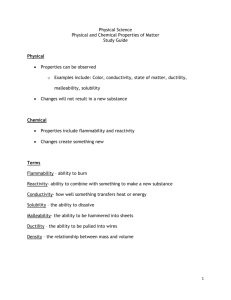BrasilFire 2002 Summary of Proposed Activity
advertisement

BrasilFire 2002 Summary of Proposed Activity November 26, 2001 Cerrado Fire Ecology: • • • • • • • Organize and conduct in Brasilia a short course for technology transfer of Cerrado Photo Series Vol. I for Bomberios, IBAMA, IBGE, Parks, and other natural resource and fire managers. This activity will include preparation of a short course agenda and lesson plans for teaching that will be used in the first course and other outreach activities. To distribute the photo series to Brazilian users. The distribution includes outreaching most of the potential users of the photo series. Extensive outreach will be achieved by mass mailing of a pamphlet hat has been prepared for that purpose. To build a database of name, address, e-mail, phone number and number of photo series requested from each individuals. This data base will be used for mailing for future series and for follow up and to document the usefulness of the series. Complete data reduction for the Cerrado units photographed in 2001. This will include reduction and analysis of biomass, and summarization for entry into the photo series layout. Compile Cerrado biomass consumption data including weather, fuels, consumption information and complete simple regression analysis to compare consumption with independent variables. To model fuel consumption or describe models already developed or proposed. Assess where the gaps may exist in producing a robust model and determine how to fill in those gaps in future Cerrado prescribed fires. Continue collaboration with the University of Brasilia to locating sites for phase II of the photo series. The second photo series volume will include sites representing Cerradao, Campo Rupestre, and Mata physiognomic forms of Cerrado. An assessment will be prepared to find the gaps that will be covered in this new phase of the photo series. Initiate a fire ecology and flammability project near Brasilia. The sites will also be used to develop a set of ground truth data for use by Phil Riggan and Jim Brass, from the FS PSW and NASA Ames respectively, in their aerial imagery research. Work will include locating sites that can be burned under different weather and moisture regimes in order to determine flammability thresholds, and will use inventory techniques and photo series methodologies to document the response of vegetation to the fires. Collaborate with the University of Brasilia and The Nature Conservancy to develop a project that to study fire exclusion and flammability at the Grande Sertao Veredas National Park. Flammability and Combustion in Mata Amazonica/Cerrado Transition Zone: • • • • • • • • • • Complete data analysis and integrate results for the field burning trials from 1997 to 2001 at the Fazenda Caiabi and publish results in scientific journals and meetings (6 scientific journal publications and conference proceedings in the United States and Brazil). Two papers are in preparation and will be submitted to refereed international journals. To distribute widely in Brazil the paper on biomass fire consumption and carbon release in the Amazon. The paper will be mailed to scientists, land managers, decision makers, and other interested people whose work relates to fire and carbon issues in the Amazon. To complete and publish the smoldering combustion work that Dr. Fernando de Costa from INPE started during his postdoctoral stay at the FS Corvallis Laboratory. Dr. Costa will finish in INPE the modeling and field studies of smoldering combustion that he started at the Corvallis Forestry Sciences Laboratory under the direction of Dr. Sandberg. His work includes theoretical work with support from laboratory work that is conducted at the Oregon State University, INPE's facilities, and field sites in Alta Floresta. The model will be tested at INPE's Combustion and Propulsion Laboratory in Cachoeira Paulista and in field burning in Alta Floresta during the summer of 2002. The work is being reviewed and will be published in an international journal. Complete and publish in the Spring quarter of 2002 Gustavo Negreiros' Ph.D. dissertation on primary forest flammability. Mr. Negreiros submitted a second draft of the dissertation that was reviewed by faculty members of the University of Washington. Prepare new field experimental sites for smoldering consumption, smoke emissions, and escaped fire analysis on Fazenda Caiabi. To conduct a combustion experiment and smoke emissions in the summer of 2002 at the Fazenda Caiabi to test methodologies for flaming and smoldering combustion, charcoal formation, and escape of fires into the primary forest. To monitor the natural drying of large fuels from the time trees are felled to when burning occurs. The study will monitor the process of natural drying of logs as a function of sun radiation, wind, air and soil temperature, air relative humidity, and rainfall. The results will be related to combustion efficiency of logs burned in land clearing fires. Results from this study are expected to guide burning policies regarding burning windows for the Amazon region. Partial results from 1999 and 2001 have been presented in Brazilian congresses. A manuscript is being prepared for publication. Continue the development of a flammability model for fires that occur in undisturbed primary forest and near the edges of pastures in fragmented forest outside of Alta Floresta. The understory fire will be monitored with a network of thermocouples to assess spread and intensity of the flaming front. Continue a dissertation research in smoldering combustion at the INPE's Combustion and Propulsion Laboratory at Cachoeira Paulista. A combustion furnace has been built and half of the tests have been conducted up to the Fall of 2001. Combustion tests will be completed during the Spring of 2002. The tests are conducted with logs from Amazonian species. Biomass combustion gases from the laboratory tests are being analyzed too. Continue the support of a scientific initiation research project by UNESP students to determine the relation of wood properties with branch and log diameters with rates of smoldering and smoke emissions from tropical biomass. This research is being conducted at INPE's LCP in Cachoeira Paulista. To monitor an operational burning in a fazenda near the city of Alta Floresta. The Fazenda Caiabi and the new fazenda site will be used to develop a set of ground truth • data for the aerial campaign conducted in the Amazon by Phil Riggan from the USFS Riverside Fire Laboratory, and James Brass from NASA. The work will include on-site monitoring of flammability thresholds, burning environment, and fuel conditions. This part of the work is contingent upon coordination with the aerial campaign and burning permits issued by IBAMA in Alta Floresta. Prepare a plan to develop and test a fine fuel flammability model that will validate the PROARCO model predictions will represent local ecological and weather variations. A planning meeting with Dr. Alberto Setzer to define some details to coordinate the work. A follow-up meeting is schedule for February to the PROARCO operations center in Cachoeira Paulista and Sao Jose dos Campos. Work Planned but Not Funded in FY02: • • • Develop a fine fuel moisture model, incorporating mesoscale meteorology and canopy interactions to support the PROARCO fire risk assessment. Continue the development of a fire risk model through the incorporation of data collected from previous year's field campaigns, satellite imagery, soils, and climate and vegetation data. Monitor escaped fires occurring on the vicinity of Alta Floresta during the peak of the fire season. Follow the daily progression of those fires and monitor weather, fuel, and vegetation conditions and use the information to model when fires will potentially go out or restart. Flammability and Low-Impact Harvesting on Floresta Nacional do Tapajos: • • • • • • Complete data analysis from the 1998 and 1999 field campaigns at the FLONA Tapajos and publish results in scientific journals and meetings (One journal publications and one conference proceedings) Continue the fire risk and ecological assessment of fire in harvested and undisturbed forest blocks at the Floresta Nacional do Tapajos. Monitor fire weather and fine fuel moisture content in paired experiment. The 2002 campaign will include the blocks harvested in 1997, 1999, 2000, 2000, and 2001. Assessment of fuel loadings, understory vegetation, and canopy disturbance and recovery after 5, 3, 2, and 1 years after logging. If needed, we will monitor the current ongoing logging project at the FLONA. Publish report preliminary results from USAID low-impact harvesting fire risk assessment, while continuing to collect data for two more years. Resume flammability tests in low-impact harvested forest late in the dry season, if one develops. Initiate the integration of results in a fire hazard model for selectively logged forests. To develop a set of recommendations for reducing fire risk in harvested tropical forests. PRINCIPAL CONTACTS: David V. Sandberg. USDA Forest Service, Pacific Northwest Research Station. 3200 SW Jefferson Way, Corvallis, Oregon 97331-4401. Tel: 541-750-7265, Fax: 541-750-7329. Email: dsandberg@fs.fed.us. Roger Ottmar. USDA Forest Service, Pacific Northwest Research Station. Fire and Environment Research Applications. 4043 Roosevelt Way NE, Seattle, WA. 98105-6947. Tel: (206) 7327826. Fax: (206) 732-7801. Internet email: ottmar@fs.fed.us. Ernesto Alvarado. College of Forest Resources. University of Washington. 4043 Roosevelt Way NE. Seattle, WA. 98105-6497. USA. Tel: (206) 732-7842. Fax: (206) 732-7801. Email: alvarado@u.washington.edu Dr. João Andrade de Carvalho Jr. Universidade Estadual do Sao Paulo and Laboratório de Combustão e Propulsão, Instituto Nacional de Pesquisas Espaciais. Rodovia Presidente Dutra km 40. Cachoera Paulista-Sao Paulo, Brasil 12630-000 Tel: +55(12)561-1377 ramais 9217/9272, Fax: +55 (12)561-1992. Email: joao@cptec.inpe.br Dr. Heloisa Miranda. Departamento de Ecologia. Universidade de Brasilia. 70.910 Brasilia, D. F. Brazil. Tel. +55(61)273-4571 Email: hmiranda@guarani.unb.br Fernando de Souza Costa. USDA Forest Service, Pacific Northwest Research Station. 3200 SW Jefferson Way, Corvallis, Oregon 97331-4401. Tel: 541-750-7361, Fax: 541-750-7329. Email: fcosta@fs.fed.us (no longer valid email address) Dr. Niro Higuchi. Instituto Nacional de Pesquisas da Amazônia. INPA/CPST- Caixa Postal 478. Campus V-8. 68.083-000. Manaus, Amazonas. Brasil. Tel: +55(92) 642-3432, Fax: +55(92) 6421706. Email: niro@inpa.gov.br.






